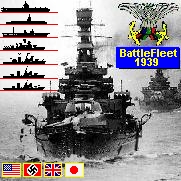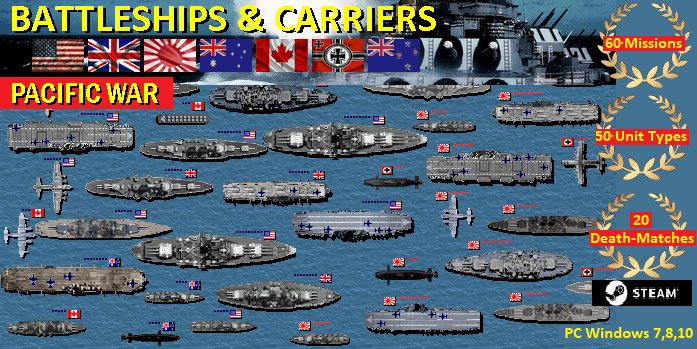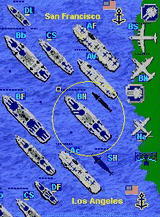|
Battleship Game - WW2 Naval
Strategy: the best choice among aircraft carrier games and submarine and battleship games.
Missions and Scenarios:
Pearl Harbor Game
Atlantic Game 1943
Sink Cruisers Game
Midway Game
Iwo Jima Game
US Marines Game
Luftwaffe Game Pacific
Torpedo Game Boats
Bismarck Game Pacific
Destroy RAF Game
Okinawa
Us Navy Submarine Game
Fleet Submarines Game
Kamikaze Game
U Boat Game
Singapore Game
Swordfish Hunt
Patrol Boats
Air Supremacy
Alert
Battleships Game
Java
Defense
Fleet Cruisers Game
Atlantic Island
Coral Sea Game
Iron Sea
Mykonos
Imperial Ocean
Long Convoy
Skagerrak
Target Los Angeles
West Pacific Game
Pacific War Game
Leyte Transport
Emperor Hirohito
Normandy Game
South Pacific Game
Destroy USAF Game
Submarine Games
US Navy Game
Free Hunt Doenitz Game
Free Hunt Spruance Game
Free Hunt Halsey Game
Imperial Navy I
|
Doolittle Raid on Japan - WW2 Battles, 18
April 1942
The April 1942 air attack
on Japan, launched from the aircraft carrier Hornet
and led by Lieutenant Colonel James H. Doolittle, was the
most daring operation yet undertaken by the United States
in the young Pacific War. Though conceived as a diversion
that would also boost American and allied morale, the
raid generated strategic benefits that far outweighed its
limited goals.
The raid had its roots in
a chance observation that it was possible to launch Army
twin-engined bombers from an aircraft carrier, making
feasible an early air attack on Japan. Appraised of the
idea in January 1942, U.S. Fleet commander Admiral Ernest
J. King and Air Forces leader General Henry H. Arnold
greeted it with enthusiasm. Arnold assigned the
technically-astute Doolittle to organize and lead a
suitable air group. The modern, but relatively
well-tested B-25B "Mitchell" medium bomber was
selected as the delivery vehicle and tests showed that it
could fly off a carrier with a useful bomb load and
enough fuel to hit Japan and continue on to airfields in
China.
Gathering volunteer air
crews for an unspecified, but admittedly dangerous
mission, Doolittle embarked on a vigourous program of
special training for his men and modifications to their
planes. The new carrier Hornet was sent to the
Pacific to undertake the Navy's part of the mission. So
secret was the operation that her Commanding Officer,
Captain Marc A. Mitscher, had no idea of his ship's
upcoming employment until shortly before sixteen B-25s
were loaded on her flight deck. On 2 April 1942 Hornet
put to sea and headed west across the vast Pacific.
Joined in mid-ocean on 13
April by Vice Admiral William F. Halsey's flagship Enterprise,
which would provide air cover during the approach, Hornet
steamed toward a planned 18 April afternoon launching
point some 400 miles from Japan. However, before dawn on
18 April, enemy picket boats were encountered much
further east than expected. These were evaded or sunk,
but got off radio warnings, forcing the planes to take
off around 8 AM, while still more than 600 miles out.
Most of the sixteen B-25s,
each with a five-man crew, attacked the Tokyo area, with
a few hitting Nagoya. Damage to the intended military
targets was modest, and none of the planes reached the
Chinese airfields (though all but a few of their crewmen
survived). However, the Japanese high command was deeply
embarrassed. Three of the eight American airmen they had
captured were executed. Spurred by Combined Fleet
commander Admiral Isoroku Yamamoto, they also resolved to
eliminate the risk of any more such raids by the early
destruction of America's aircraft carriers, a decision
that led them to disaster at the Battle of Midway a month
and a half later
People of the
Doolittle Attack
After dropping their
bombs, mainly on or near their intended targets,
Doolittle's sixteen B-25B bombers left Japanese airspace,
essentially unhindered by enemy air interception and
anti-aircraft gunfire. One of them, suffering from
excessive fuel consumption, had no hope of reaching China
and so headed for the closer Soviet Maritime region.
After landing north of Vladivostok, this plane and its
five crew members were interned by the then-neutral
Soviet authorities. The crew ultimately returned to the
U.S. by way of Iran.
The other fifteen planes,
with their seventy-five men, flew on toward China, where
darkness forced four to crash-land or ditch offshore.
With fuel running out after some fifteen hours of flying,
eleven crews took to their parachutes. Three men were
killed at this time. Local residents saved most of the
others and heroically spirited them through Japanese-held
territory to safety. The vengeful enemy retaliated with a
vicious ground offensive, killing tens of thousands of
Chinese over the following months. The Japanese also were
able to capture eight men from two planes' crews. Three
of these prisoners of war, Second Lieutenants Dean E.
Hallmark and William G. Farrow and Sergeant Harold A.
Spatz, were executed at Shanghai in October 1942.
Another, Lieutenant Robert J. Meder, died in prison more
than a year later.
The remaining airmen
eventually returned to duty with the Army Air Forces, and
twelve of these lost their lives later in the war. Their
leader, Lieutenant Colonel Doolittle, was quickly
promoted to Brigadier General and awarded the Medail of
Honor. Twenty-three of his men received Distinguished
Flying Crosses. One of the latter, the seriously injured
2nd Lt. Ted W. Lawson, wrote a best-selling memoir of the
raid and its aftermath. In 1944, this book, "Thirty
Seconds Over Tokyo", served as the basis for a
Hollywood motion picture of the same name
Ships of the
Doolittle Attack Task Force
In addition to the carriers Hornet and Enterprise,
fourteen other U.S. Navy ships made up the raid task
force, which was led by Vice Admiral William F. Halsey
and designated Task Force 16. Three were heavy cruisers,
Salt Lake City (CA-25), Northampton (CA-26) and Vincennes
(CA-44). USS Nashville (CL-43) was a light cruiser. The
eight destroyers were Balch (DD-363), flagship of Captain
Richard L. Conolly's Destroyer Squadron Six, Benham
(DD-397), Ellet (DD-398), Fanning (DD-385), Grayson
(DD-435), Gwin (DD-433), Meredith (DD-434) and Monssen
(DD-436). Vital members of the long-range team were the
oilers Cimarron (AO-22) and Sabine (AO-25).
After launching the raid's bombers toward Japan, the task
force retired to Pearl Harbor, arriving on 25 April. The
force was soon urgently dispatched toward the South
Pacific, but the 7-8 May Battle of the Coral Sea took
place before it could arrive. Recalled to Pearl, both
carriers and seven of the other Doolittle raid ships were
sent off toward the northwest, where they took part in
the Battle of Midway on 4-6 June 1942.
Six of the raid's sixteen ships would be lost in
August-December 1942, during the intense fighting of the
Guadalcanal Campaign: Hornet, Vincennes, Northampton,
Benham, Meredith and Monssen. A seventh, Gwin, was sunk
by a Japanese torpedo in July 1943, during the Battle of
Kolombangara.
An interesting sidelight of the operation was an early
example of airborne shore-to-ship logistics support, when
the Navy blimp L-8 flew out over the Pacific to deliver
urgently-needed aircraft parts directly to Hornet's
flight deck.
In July 1942, Doolittle as a Brigadier General - he had
been promoted by two grades on the day after the Tokyo
attack, by-passing the rank of full colonel - Doolittle
was assigned to the nascent Eighth Air Force and in
September became commanding general of the Twelfth Air
Force in North Africa. He was promoted to Major General
in November 1942, and in March 1943 became commanding
general of the Northwest African Strategic Air Forces, a
unified command of U.S. Army Air Force and Royal Air
Force units.
Maj. Gen. Doolittle took command of the Fifteenth Air
Force in the Mediterranean Theater of Operations in
November 1943. On June 10, he flew as co-pilot with Jack
Sims, fellow Tokyo Raider, in a B-26 Marauder of the
320th Bombardment Group, 442nd Bombardment Squadron on a
mission to attack gun emplacements at Pantelleria.
Doolittle continued to fly, despite the risk of capture,
while being privy to the Ultra secret, which was that the
German encryption systems had been broken by the
British.[3] From January 1944 to September 1945, he held
his largest command, the Eighth Air Force (8 AF) in
England as a Lieutenant General, his promotion date being
March 13, 1944 and the highest rank ever held by a
reserve officer in modern times. Doolittle's major
influence on the European air war occurred early in the
year when he changed the policy requiring escorting
fighters to remain with the bombers at all times. With
his permission, P-38s, P-47s, and P-51s on escort
missions strafed German airfields and transport while
returning to base, contributing significantly to the
achievement of air supremacy by Allied Air Forces over
Europe.
After the end of the European war, the Eighth Air Force
was re-equipped with B-29 Superfortress bombers and
started to relocate to Okinawa in the Pacific. Two bomb
groups had begun to arrive on August 7. However, the 8th
was not scheduled to be at full strength until February
1946 and Doolittle declined to rush 8th Air Force units
into combat simply to say that "the 8th Air Force
had operated against the Japanese in the Pacific".
On May 10, 1946, Doolittle reverted to inactive reserve
status at the grade of lieutenant general. He returned to
Shell Oil as a vice president, and later as a director.
In 1947, Doolittle became the first president of the Air
Force Association, an organization which he helped
create.
In March 1951, Doolittle was appointed a special
assistant to the Chief of Staff of the Air Force, serving
as a civilian in scientific matters which led to Air
Force ballistic missile and space programs. In 1952,
following a string of three air crashes in two months at
Elizabeth, New Jersey, Harry S. Truman appointed him to
lead a presidential commission examining the safety of
urban airports. The report "Airports And Their
Neighbours" led to zoning requirements for buildings
near approaches, early noise control requirements, and
initial work on "super airports" with 10,000 ft
runways, suited to 150 ton aircraft.
Doolittle retired from Air Force duty on February 28,
1959. He remained active in other capacities, including
chairman of the board of TRW Space Technology
Laboratories.
In 1972, Doolittle received the Tony Jannus Award for his
distinguished contributions to commercial aviation, in
recognition of the development of instrument flight.
On April 4, 1985, the U.S. Congress promoted Doolittle to
the rank of full General on the Air Force retired list.
In a later ceremony, President Ronald Reagan and U.S.
Senator and retired Air Force Reserve Major General Barry
Goldwater pinned on Doolittle's four-star insignia.
In addition to his Medal of Honor for the Tokyo raid,
Doolittle also received the Presidential Medal of
Freedom, two Distinguished Service Medals, the Silver
Star, three Distinguished Flying Crosses, the Bronze
Star, four Air Medals, and decorations from Great
Britain, France, Belgium, Poland, China, and Ecuador. He
is the only person to be awarded both the Medal of Honor
and the Medal of Freedom, the nation's two highest
honors. Doolittle was awarded the Public Welfare Medal
from the National Academy of Sciences in 1959.[4] In
1983, he was awarded the United States Military Academy's
Sylvanus Thayer Award. He was inducted in the Motorsports
Hall of Fame of America as the only member of the air
racing category in the inaugural class of 1989, and into
the Aerospace Walk of Honor in the inaugural class of
1990. The headquarters of the United States Air Force
Academy Association of Graduates (on the grounds of the
United States Air Force Academy), Doolittle Hall, is
named in his honor.
On May 9, 2007, The new 12th Air Force Combined Air
Operations Center, Building 74, at Davis-Monthan Air
Force Base, Tucson, Arizona, was named in his honor as
the "General James H. Doolittle Center."
Several surviving members of the Doolittle Raid were in
attendance during the ribbon cutting ceremony.
|
| |
 |
 |
| Turn-based WW2
naval game, extension to the classic
Submarine game (Battleship game) where
ships/planes/subs can move. Contains plenty of
game missions, game campaigns and 40 ship,
submarine, airplane ana port artillery types,
with combat maps up to 96X96 large. |
| |
| |
| |
|
Turn-based space
strategy game represents World War 4
conflict on tactical level.
The user-friendly game engine allows more than 60
unit types, including planet battleships, galaxy
cruisers, death-stars, stealth units, star
destroyers, air-space interceptors, explorers,
planet artillery and radars. |
| |
| |
|
| Tycoon Strategy
Game - build your own world business empire as an
arms dealer tycoon. Travel around the world,
trade with more than 400 weapon systems, hire
secretaries, bodyguards, lawyers, fighters and
tanks, establish companies and search for
criminals and hostages. |
| |
|


